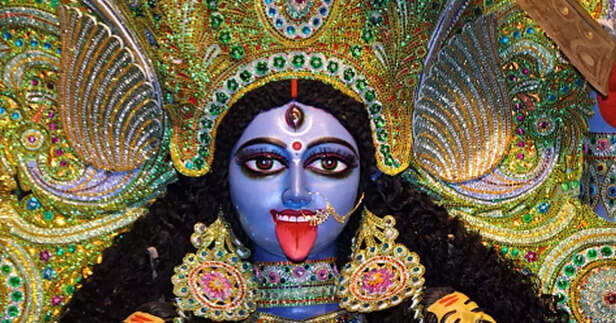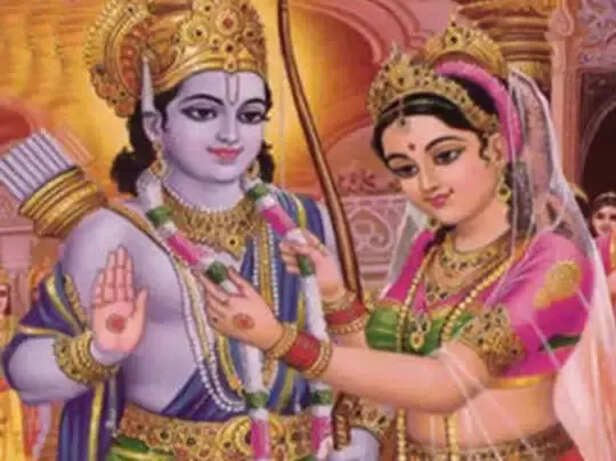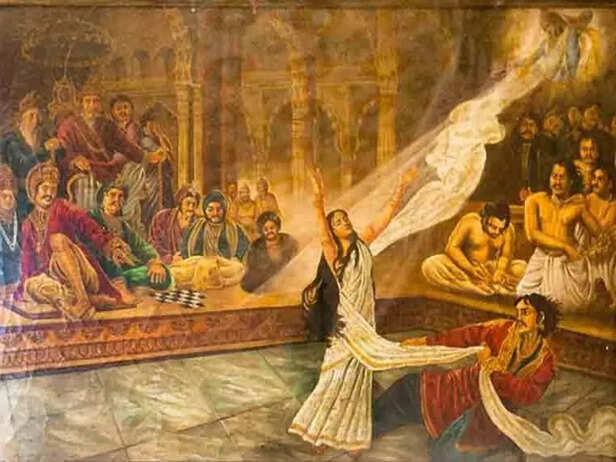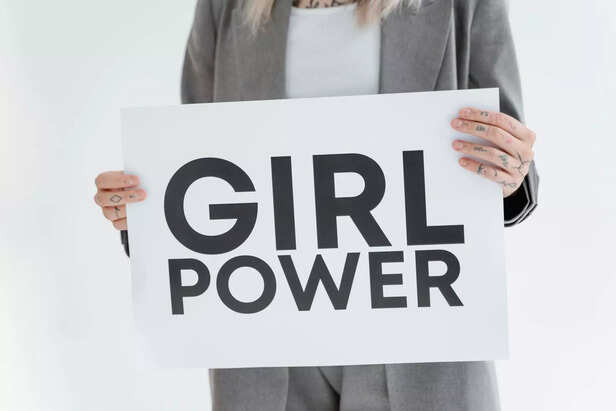Sanatan Dharma Gave Women Power - Society Took It Away ?
Riya Kumari | Apr 09, 2025, 23:51 IST
( Image credit : Timeslife )
So, picture this: You're sipping overpriced coffee at your favorite café, scrolling through your feed, dodging yet another #WokeUpLikeThis selfie—when boom. A post hits you like the plot twist in a Shonda Rhimes finale: “In Sanatan Dharma, women were worshipped. Literally.” And you're like… wait, what? Because, somewhere between "Devi" and "Don't wear that," something got seriously lost in translation. Let's rewind the reel, shall we?
We often hear phrases like “In our culture, women are goddesses.” It's repeated with pride, passed down like family heirlooms. But if we were to pause—really pause—and ask: What happened between that reverence and the reality we see today? The silence would be deafening. Because here’s the truth: Sanatan Dharma empowered women long before the world learned the word "feminism." It gave them voice, agency, and spiritual authority. What took it away wasn’t religion—it was interpretation. It was fear disguised as tradition. It was power dressed up as protection. This isn’t an attack on culture. This is an invitation to remember what it really was—before society rewrote the rules to suit itself.
1. Our Scriptures Didn’t Fear Powerful Women. Society Did

Take a look at our foundational stories—not the sanitized, dinner-table versions, but the real, complex ones. Draupadi wasn’t a passive bride—she was a sharp, outspoken queen who questioned injustice in a room full of kings. Gargi debated philosophy with male sages in royal courts. She didn’t just participate—she won. Kali isn’t just a fierce image in a frame. She represents the power of destruction only to protect what is sacred.
These women weren’t sidelined—they were central. Not in a token way, but in a way that acknowledged their wisdom, their strength, their voice. What followed wasn’t dharma. It was dilution. Over centuries, stories were shortened. Symbols were softened. Women went from creators of life to keepers of kitchens. Not because the Vedas asked for it—but because society got uncomfortable. And when society gets uncomfortable, it calls control “morality.”
2. From Sacred to Silenced: How Reverence Was Rewritten

Sanatan Dharma speaks in metaphors. The problem is, society took them literally, and then weaponized them. Lakshmi became a symbol of wealth and fortune—yet how often is she reduced to being the “ideal wife” who stays quiet, sacrifices endlessly, and never complains? Sita, once a symbol of strength and purity, became a yardstick used against real women. We forget—she walked through fire not because she was weak, but because her strength was doubted. And that broke her. Not the fire. The doubt.
Sanatan Dharma told us women are Shakti—the cosmic energy that fuels everything. But we turned Shakti into someone who must always smile politely, eat last, and speak less. This isn’t just misinterpretation. It’s loss. And it's a loss we’re still living.
3. Why This Still Matters Today

Because if you strip away the stories, what’s left is the mindset. And that mindset is still alive. It’s there when a girl is told to adjust, not dream. It’s there when a working woman is praised only if her house is spotless. It’s there when daughters are taught to shrink themselves in the name of “tradition.”
But tradition, real tradition—the kind our ancestors lived by—wasn’t built on fear. It was built on balance. On complementarity. On respect. Dharma was never about hierarchy. It was about harmony. And harmony dies the moment one voice is silenced so another can dominate.
4. Returning to the Root, Not the Ruin

We don’t need to discard our culture to move forward. That’s a false choice. What we need is to unlearn the layers that were never ours to carry. To return—not to the past as it was told to us—but to the root from where it began. Because in that root, women weren’t ornaments. They were origin. This isn’t just a historical correction. It’s a spiritual one.
When we reduce half of humanity to silence in the name of religion, we’re not just losing people—we’re losing meaning. Losing alignment. Losing the soul of what Sanatan Dharma stood for. And maybe that’s the real journey—to go beyond the noise and ask: What are we worshipping if we’re not honoring the living embodiments of the divine around us?
Sanatan Dharma didn’t fail women. People did
They misread it. Mistranslated it. Misused it. But here’s the beauty of dharma: it’s not static. It adapts. It awakens.
And it’s never too late to wake up. So the next time someone says “in our culture, women are goddesses,” ask them: Which version are you following? The original one that empowered them—or the revised one that erased them? One reminds us who we are. The other keeps us from ever becoming it. And the world can’t afford that kind of forgetfulness anymore.
1. Our Scriptures Didn’t Fear Powerful Women. Society Did

Kali
( Image credit : Times Life Bureau )
Take a look at our foundational stories—not the sanitized, dinner-table versions, but the real, complex ones. Draupadi wasn’t a passive bride—she was a sharp, outspoken queen who questioned injustice in a room full of kings. Gargi debated philosophy with male sages in royal courts. She didn’t just participate—she won. Kali isn’t just a fierce image in a frame. She represents the power of destruction only to protect what is sacred.
These women weren’t sidelined—they were central. Not in a token way, but in a way that acknowledged their wisdom, their strength, their voice. What followed wasn’t dharma. It was dilution. Over centuries, stories were shortened. Symbols were softened. Women went from creators of life to keepers of kitchens. Not because the Vedas asked for it—but because society got uncomfortable. And when society gets uncomfortable, it calls control “morality.”
2. From Sacred to Silenced: How Reverence Was Rewritten

Sita
( Image credit : Times Life Bureau )
Sanatan Dharma speaks in metaphors. The problem is, society took them literally, and then weaponized them. Lakshmi became a symbol of wealth and fortune—yet how often is she reduced to being the “ideal wife” who stays quiet, sacrifices endlessly, and never complains? Sita, once a symbol of strength and purity, became a yardstick used against real women. We forget—she walked through fire not because she was weak, but because her strength was doubted. And that broke her. Not the fire. The doubt.
Sanatan Dharma told us women are Shakti—the cosmic energy that fuels everything. But we turned Shakti into someone who must always smile politely, eat last, and speak less. This isn’t just misinterpretation. It’s loss. And it's a loss we’re still living.
3. Why This Still Matters Today

Draupadi
( Image credit : Times Life Bureau )
Because if you strip away the stories, what’s left is the mindset. And that mindset is still alive. It’s there when a girl is told to adjust, not dream. It’s there when a working woman is praised only if her house is spotless. It’s there when daughters are taught to shrink themselves in the name of “tradition.”
But tradition, real tradition—the kind our ancestors lived by—wasn’t built on fear. It was built on balance. On complementarity. On respect. Dharma was never about hierarchy. It was about harmony. And harmony dies the moment one voice is silenced so another can dominate.
4. Returning to the Root, Not the Ruin

Girl Power
( Image credit : Pexels )
We don’t need to discard our culture to move forward. That’s a false choice. What we need is to unlearn the layers that were never ours to carry. To return—not to the past as it was told to us—but to the root from where it began. Because in that root, women weren’t ornaments. They were origin. This isn’t just a historical correction. It’s a spiritual one.
When we reduce half of humanity to silence in the name of religion, we’re not just losing people—we’re losing meaning. Losing alignment. Losing the soul of what Sanatan Dharma stood for. And maybe that’s the real journey—to go beyond the noise and ask: What are we worshipping if we’re not honoring the living embodiments of the divine around us?
Sanatan Dharma didn’t fail women. People did
And it’s never too late to wake up. So the next time someone says “in our culture, women are goddesses,” ask them: Which version are you following? The original one that empowered them—or the revised one that erased them? One reminds us who we are. The other keeps us from ever becoming it. And the world can’t afford that kind of forgetfulness anymore.
